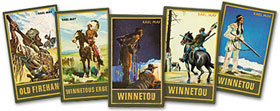
Tribes hold tot he way of their ancestors
Strength of Native culture overpowers oppression
Changing 's-word' controversial but needed to make a difference
| by Kathrin Podbrecnik A European stereotype about Europeans might be that we donít have any stereotypes about other cultures. When I was asked to write a story about European clichÈs of Native Americans, I expected to find three or four examples, but as it turned out, I was completely wrong.
|
In addition, German people sometimes make fun of someone when calling him "Indian chief smelling sock" or use the expression "Hugh, I have spoken" to clarify that they have finished speaking. These expressions are based on a common stereotype: Not only have Native Americans "funny" names that refer to objects or animals, but they also have a disjointed language. Moreover, a lot of German expressions show that we associate Native Americans with something unusual or alternative. When we speak of a "town-Indian" who has an "Iroquois haircut," we refer to someone who refuses to accept the societyís rules and dresses in an unusual way. Once again, this stereotype goes back to times when Europeans considered people other than whites as savages who did not stick to the norm. In addition, Austrian or German people have a lot of stereotypes about Native Americans that they share with other European people. In Europe, Native Americans are believed to color their faces and decorate their totem poles with scary faces and strong colors; their clothes are believed to be mainly made of feathers and leather, and they live in teepees. Their medicine men use natural remedies, they speak with the deceased and they like smoking their peace pipes. Furthermore, Europeans admire Native Americans for their capabilities: Native Americans can see an animal's trace on a path whereas we Europeans can't see anything. Moreover, Native Americans are known to have a good head for heights ‚ a stereotype that is based on the fact that many Native Americans have worked for white Americans to build skyscrapers. What is more, many Europeans think that male Native Americans never shave but still do not have beards. The common explanation for this "miracle" is that they tear out their beards until they stop growing at all. To a large extent, these stereotypes are based on famous stories by Karl May ("Winnetou"), a German teacher who wrote innumerable novels about Native Americans in the 19th century. Interestingly, May had never seen Native Americans with his own eyes. |
||||||||
|
|||||||||
